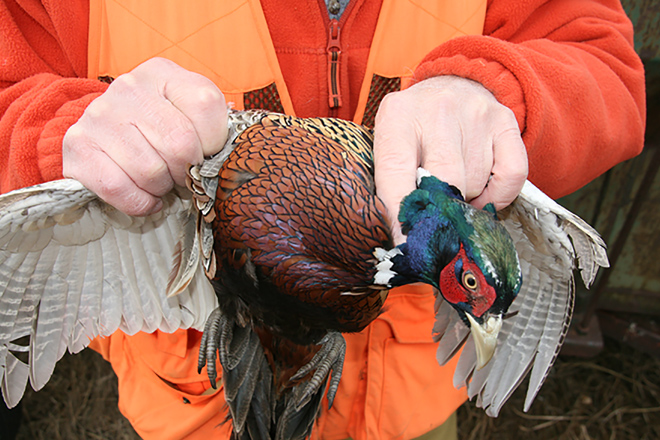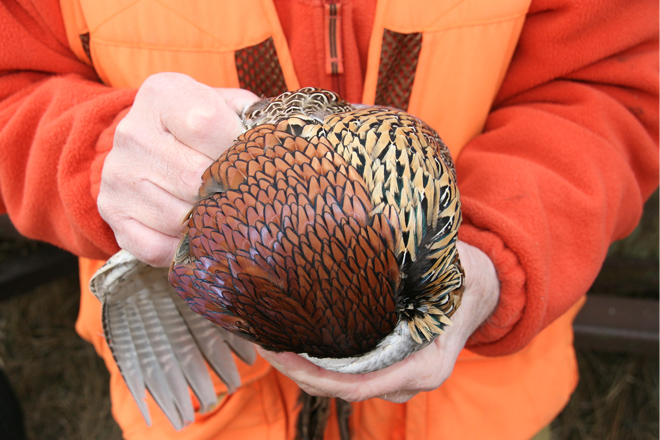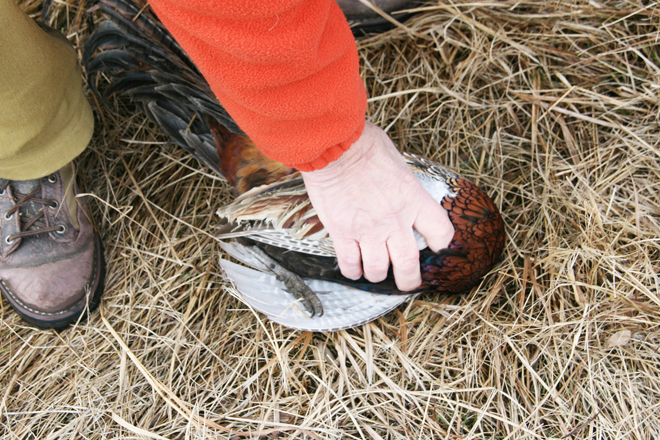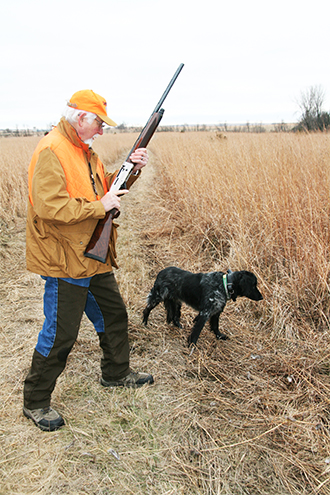Stretch, tuck and press: Guidelines for setting up game farm ringnecks to make your dog a better hunter
By Jerry Thoms
“Put the check cord on Kate’s collar then run the cord into a half hitch around her waist,” Jeff West told Jim Debeer, the owner of Kate, a 9-month-old small Munsterlander. “Then we will walk down this path in the prairie grass to see if we can find a bird for Kate to point,” West added.
Seventy-five yards into the cover Kate slammed into a perfect rock-hard point.
.
“Now take the check cord off and walk over to where Kate is looking,” West instructed Debeer. “And, if there is a bird there, flush it and shoot it.”
Sure enough, a big long-tailed rooster came flapping out of the cover and was dropped dead with one shot from Debeer’s 12 gauge. And Kate, on the “fetch” command, neatly retrieved the bird.
“How did you know that rooster was there?” Debeer innocently asked West.
“Because I put it there,” West answered.
West, in fact, has “set up” pheasants like this hundreds of times in 20-plus years of dog training by using a simple but effective method of temporarily “relaxing” the birds so any breed of pointing dog could find them. The method works for setting up young flushing dogs for success too.
For any hunter with a dog that needs to learn more about finding and retrieving) pheasants, here are the guidelines for West’s method. We realize it isn’t wild birds here, but training is the topic, and who doesn’t like to use a game farm bird now and again to help a dog learn?
GUIDELINES FOR RELAXING AND RELEASING A PHEASANT FOR GUN DOG TRAINING: THE STRETCH, TUCK AND PRESS METHOD
First of all, how to grab a pheasant from a bird-box or a bird-bag, used to transport pheasants from home to a training field, is important.
When extracting a pheasant from a standard crate, tilt the crate upright, cover two-thirds of the swinging door opening with your upper body, put your right hand and arm into the box, and tightly grasp the right wing of the bird you want to use. Pull the bird up and out and use your left hand to hold the door closed as you lower the crate into a horizontal position.
STRETCH
With one hand on each wing, gently pull both wings out to each side. This will begin to relax the bird by slowing its heartrate and lung function without causing too much stress.

TUCK
Now, with the index finger of your left hand, hook the bird’s neck and carefully pull its head under its left wing. Apply enough pressure on the left wing to hold the head in place between the underside of the wing and the bird’s body.
Construct a launch site in the cover by using the existing vegetation to hide the bird from view. Position the pheasant so that it is facing the wind and so that it will see open sky when full consciousness occurs and its head is lifted and the bird is ready to be found, and pointed/flushed or just flushed.

PRESS
Place the bird on the ground in the launch-site and gently press down on its body with your right hand for about 12 seconds. The exact length of time will depend on the bird’s size, ag, and general physical condition. The average pheasant will remain in the relaxed state for several minutes before it raises its head and is ready to take flight or, in some cases, walk a short distance.
The “stretched, tucked and “pressed” pheasant is now ready to be worked by a dog which can be brought in to find. Wait long enough to be sure the pheasant’s head is up as an indication that it’s ready to fly.

TIPS
This method of relaxing the bird is usually better than most other methods because it is less stressful and more consistent than other methods such as shaking the bird’s head or swinging the bird in a bag to dizzy it.
This is a good opportunity, with the help of a check cord and/or an e-collar, to teach and enforce “steadiness to wing, shot, and fall” for pointing dogs, as well as tracking a wounded bird or retrieving a dead one. It’s also good for giving lessons in not “crowding” or “bumping” birds that should be pointed and held from a reasonable distance.
How well does the stretch, tuck, and press method work? After all, each game farm bird we buy for training is an investment.

“About four out of five are successful attempts,” is Jeff West’s answer. “Though I’ve used this method for going on 20 years, I still haven’t perfected it, but 80 percent is a pretty good average. I learned how to use this method from Jim Meyer at Oakwood Game Farm in Princeton, Wisconsin. He has been teaching it for nearly 50 years as the preferred way to use pen-raised pheasants for training all breeds of bird dogs.”
IMPORTANT NOTES
LEGAL REQUIREMENTS IN USING PEN-RAISED PHEASANTS FOR BIRD DOG TRAINING
Though pen-raised pheasants can be legally used for bird dog training just about any time of the year and just about anywhere, do check with the state game departments for special regulations on the subject. For example, South Dakota requires a receipt for the purchase of the pheasants and 36 inches of surveyor’s tape tied to one leg of each bird to identify them in the field.
SOURCES FOR PEN-RAISED PHEASANTS
Pen-raised pheasants are for sale in every state in the USA and all the provinces of Canada. Look at the North American Gamebird Association website for suppliers nearest you.
OTHER USES FOR RELAXED PHEASANTS
A set-up pheasant can be a good way to introduce a novice hunter to the experience of a bird dog finding and pointing or flushing a ringneck rooster and then shooting the bird. Most bird dogs will also locate and retrieve the pheasant. Likewise, an older physically compromised hunter can have a similar experience.
ARE TODAY’S PEN-RAISED PHEASANTS “WILD ENOUGH” TO BE GOOD ENOUGH FOR TRAINING BIRD DOGS?
“Twenty-five years ago, I would say probably not,” was Jeff West’s opinion. Back then, many pen-raised pheasants tended to be big, fat and sloppy, preferring to sit and hide rather then fly and run when pursued by dogs. Since then, however, pen-raised pheasants have been improved by better genetics, better nutrition and better methods of raising them. Most of today’s pen-raised pheasants, when properly released, West feels, are close enough to behaving like wild birds to help the dog learn.